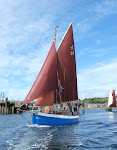After a morning of doing boat chores and chatting to Gary Lyons from the Northern Ireland OGA Julian and I walked into the town for fish and chips. Our earliest time to leave was 2pm, and we were back on board
Robinetta by then, and ready to cast off at 1425. I had been watching wind over the tide in the middle of the channel all morning, and could still see some, but when we were clear of the marina and turned downstream close to the Portaferry shore the tide did not hold us back at all. A quick turn back towards the marina put us head to wind, and we raised the main and staysail before running down the side of the channel at nearly 4 knots. There was no tide against us or under us and we had a lovely gentle run down to the cardinal at the entrance to Strangford Lough. Our timing was perfect! (we had been given a lot of advice!)
We cut inside the cardinal (just) since we were on the top of the tide, and hardened up to head north. Julian set the no 2 jib, but I soon felt overpowered on the helm and
Robinetta was heeling an uncomfortable amount so we put a reef in. The forecast had been 4-5, occasionally 6 N to NW, but it felt more like a top end 5. There was more swell than the expected “smooth to slight” too, and our foredeck got a good wash. We lowered the stay-sail, then reefed all the way down.
We had been told it was best to go inside the South Rock, which proudly boasts the oldest wave washed tower in the world still standing, but our best course to windward put us well outside, and when we tacked to head back towards the shore things became rather unpleasant. Rather that burying our bowsprit the waves were coming at us on the beam and rolling us too far over for comfort. We were also only making 1 knot under sail, and turning the engine on made things more uncomfortable without speeding us up noticeably. We quickly turned back onto the other tack and had a think. We were making 3 knots at best, and at some point we would have to tack towards the land. There was just too much west in the wind to make reaching Bangor marina possible in any sensible time frame, and the sea was very unfriendly.
Peel would have been possible, but we would have been at a bad angle to the waves again, and although we could see the Isle of Man it was several hours away. There was only one easy place to go, and that was downwind, back towards Strangford. We could not get in there due to the tide, but Ardglass made a perfect port of refuge.
We turned away from South Rock, and headed south instead. Life immediately felt easier. The seas were still big, (for
Robinetta), but they lifted her stern and rolled under her. We were making a comfortable 4 knots, and although steering still took effort it was easy to control. As we headed south the waves got smaller, although the wind was still gusting to 6, and we crossed the Strangford Entrance without encountering any confused seas. We were ferry gliding rather than going where
Robinetta's bows pointed for half an hour as the tide pushed us away from the land, which was not a problem as we had the chartplotter to tell us where we were actually going.
Julian rigged the pulley system to help me hold the course, and we sailed right up to Ardglass, only putting the engine on when we turned into the harbour entrance and were head to wind. The sails came down in a rush, and we headed cautiously in. It did not look much like the picture in the pilot book, or the chart, and there was a cardinal that was not on either. We crept in, keeping close to the cardinal, then followed the channel round to the marina. There were more boats in here than at Portaferry, but there were still plenty of empty berths. Not knowing which were visitor berths I did not head for the closest, but picked a berth where we would be blown off.
A gentleman in a motor yacht came and took out lines, and tried to pull us in.
Robinetta would not budge, and it took a couple of minutes to spot that
Worm had got stuck behind a finger of the pontoon and was acting as a mooring; we had forgotten to shorten the towing line as we came in. Once
Worm was free
Robinetta moved easily into her berth. The gentleman who had helped us moor up had tried the same trip as us, and described his boat as “flying” off the waves. Not something a motor boat should do, and like us he had turned south and taken refuge in Ardglass.
The weather forecast for tomorrow is the same as today, meaning there is no point us trying to head north again. Then on Monday the weather gets worse, with real gales, not just a force 6 “yachtsmans”. We will probably continue to head south, to Howth, (or Carlingford if Howth feels too far) and sit out the gale there. We will have to see what tomorrow morning's forecast brings before we finalise our decision.
















